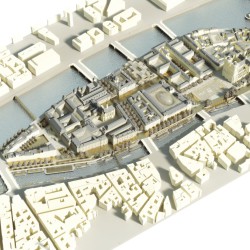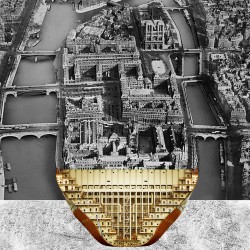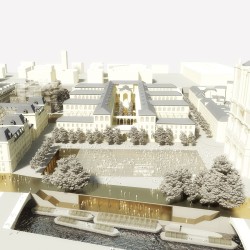DPA | DOMINIQUE PERRAULT ARCHITECTURE
Dominique Perrault and Philippe Bélaval’s project aims to bring life back into the Île de la Cité, whose population has been dwindling for decades. Over the course of the nineteenth century, as residential buildings and activities were replaced by major public institutions, the island gradually turned into an administrative hub. Today the partial relocation of Paris’s Court of Justice, Police headquarters and oldest hospital, the Hôtel-Dieu, into other areas of the city, leaves room for a repurposing of the buildings.
The mission aims to propose a new future, over the next 25 years, for the Île de la Cité, a monument-island located in the heart of Paris and the metropolis. With this new study, the island would enter a historical era. Indeed, the island’s last urban renovation was led by Baron Haussmann in the 19th century.
_
35 PROPOSALS
Imagined together or individually, the thirty-five proposed interventions on the Île de la Cité, are designed to make it possible to reveal its monuments, diversify its uses, highlight its institutions and reclaim its public spaces. These proposals are intended to foster a comprehensive architectural, political and economic reflection on the future of the island, which will associate all the public and private stakeholders, starting with the offices of the public administrations located on the Île de la Cité.
On the Île from end to end and through the institutional promenade, discover the proposals in their entirety, opposite.
After a first era spanning over ten centuries, from the foundation of Paris to the French revolution, the island was transformed for the first time during the urban renovation of Paris by baron Haussmann and Napoleon III. With this new project, slated to be completed in 2040, the island will enter a third historical era.
·
·
The Île de la Cité, at the heart of the city of Paris and the metropolis of the Île de France, offers an exceptional ensemble of urban landscapes, monuments, historical memories, and literary and artistic reminiscences.
The emotional charge is so powerful that we could almost forget reality. The one of a history beginning with over a thousand years of organic urbanization, fighting against the Seine, to the point of breaking its rapport with geography. The one of a violent mutation, when Napoléon III and the Baron Haussmann implemented, under the guise of hygienic urbanism, an imperial plan for controlling the public space through its administration and to the detriment of its appropriation by the citizens. Finally, the one of today, which on it’s great empty squares reveals the island is deserted by the Parisians and essentially unknown to tourists, which behind the its nobles façades masks a paradoxical and painful relationship of public administrations with their built premises, the source of both their pride and their discomfort.
In the midst of the hermetic façades of the Palais de Justice, the Hôtel-Dieu and the Préfecture de Police, the absence of a clear definition of the status of each public space is an impediment to the community’s
appropriation of the insular Cité. Shops are rare. The intense traffic of visitors to the cultural and tourist sites of the cathedral, the Conciergerie and the Sainte-Chapelle are insufficient for restoring an island whose demography is declining to a lively neighborhood.
Today, the opportunity exists to begin a new period in the history of the Île de la Cité. While the major administrations prepare their future, and the center of Paris is experiencing a series of key evolutions, from La Samaritaine to the reclaiming of the banks of the Seine, and with the perspective of holding the 2024 Olympic Games and the 2025 world’s fair of inviting the entire world to rediscover the City of Lights, the Île de la Cité appears to be the most apt district for deploying an ambitious major urban, cultural, architectural and economic project, which will also contribute to enhancing the global influence of France.
The urban project presented here proposes to move forward along the path of a project for the ensemble, gradually evolving the island of monuments toward an “island monument.”The interest of this approach it to take advantage of the force of driving a comprehensive project to be able to overcome the numerous technical, legal, and financial obstacles, while also striving to ensure the subtlety of architectural interventions, which will aim to respect and
highlight this heritage recognized by Unesco as being of exceptional universal value and which is so dear to us.
I n order to maintain the architec tural coherence of the ensemble, the fictions accompanying the assessment are designed to reveal the many possibilities by taking advantage of each one of the island ’s anfractuosities, its hidden spaces, interior courtyards, passages and its underground zones. This work recalls the wealth of an island that is paradoxically not very dense and whose available property is estimated at more than 100,000 sqm, guaranteeing the economic realism underpinning a grand project.
However, to ensure this policy will be sustained for the duration of the ambitious 25-year project, the island must first rekindle the interst of the citzens of Paris. This could begin tomorrow, by making the southern quays into a pedetrian zone, and continue to 2024, with a unified public space on the central quare linking the Palais de Justice and the Hôtel-Dieu, and be completed in 2040 with greater openness to the public in all of today’se institutional fortresses.
The ambitious project presented here is no less than to restore its beating heart to the city of Paris.
















